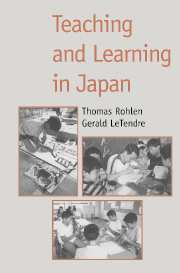Book contents
- Frontmatter
- Contents
- List of contributors
- Introduction: Japanese theories of learning
- Section I Fundamental approaches
- Section II The emotional foundations of early learning
- Section III School and classroom models
- Section IV Path and guidance
- Section V Artistic pursuits – old and new
- Try, try again: training in noh drama
- The Suzuki Method of music instruction
- Conclusion: themes in the Japanese culture of learning
- References
- Index
The Suzuki Method of music instruction
Published online by Cambridge University Press: 05 June 2012
- Frontmatter
- Contents
- List of contributors
- Introduction: Japanese theories of learning
- Section I Fundamental approaches
- Section II The emotional foundations of early learning
- Section III School and classroom models
- Section IV Path and guidance
- Section V Artistic pursuits – old and new
- Try, try again: training in noh drama
- The Suzuki Method of music instruction
- Conclusion: themes in the Japanese culture of learning
- References
- Index
Summary
Talent Education, or the Suzuki Method, as it is better known internationally, is an interesting and highly successful method of teaching young children to play musical instruments. Although developed only forty years ago in Japan by Shinichi Suzuki, a Japanese violinist, it now has branches in twenty-three countries and approximately 300,000 students [use it] worldwide. The method's very young students have attracted considerable public notice through their mass performances of difficult works for violin and piano which were previously the province of professional musicians and occasional child prodigies. Although the method itself remains a quintessentially Japanese approach to education which embodies deeply rooted Japanese cultural assumptions, its successful implementation in numerous foreign countries demonstrates its widespread appeal and ability to survive transplantation to other cultures. In the process of being adopted by other countries, certain aspects of the method have been modified to fit the indigenous educational attitudes and practices of the recipient cultures. This is particularly evident in the United States, where the method differs in a number of important respects from the way it is practiced in Japan.
This [essay] will briefly describe the Suzuki Method, and then consider various aspects in which the method demonstrates particularly striking continuity with traditional and contemporary Japanese educational attitudes and practices. Finally, some observations on how the American Suzuki Method has been adapted to better fit typical American cultural attitudes and practices will be presented.
- Type
- Chapter
- Information
- Teaching and Learning in Japan , pp. 345 - 368Publisher: Cambridge University PressPrint publication year: 1996
- 2
- Cited by

